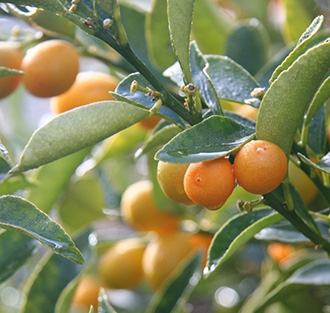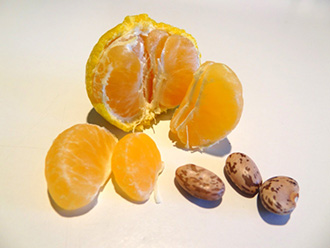|

Fall flavors include plenty of juicy fruits
By Urban Harvest
 When thinking about fall flavors, the tastes of a turkey dinner come to mind - sage, cinnamon, nutmeg. To Gulf Coast gardeners, fall flavors include sometimes sweet, sometimes sour, but always juicy citrus. A well planned selection of citrus will provide fruit from the end of summer through the start of the New Year. When thinking about fall flavors, the tastes of a turkey dinner come to mind - sage, cinnamon, nutmeg. To Gulf Coast gardeners, fall flavors include sometimes sweet, sometimes sour, but always juicy citrus. A well planned selection of citrus will provide fruit from the end of summer through the start of the New Year.
From a landscape perspective, citrus are small evergreen trees that provide screening from unsightly views. Their blossoms impart a delicate fragrance to the garden and attract the Giant Swallowtail Butterfly. The boughs provide an excellent habitat for songbirds.
Citrus trees are easy care as well. Start your own citrus orchard by planting in an area of the garden that receives at least a half day of sun. Citrus do not require full sun as do most other fruit trees. When planting, ensure the graft is planted a couple of inches above the soil line.
Most citrus have good cold tolerance, but if we experience a hard, extended freeze, you may want to provide protection. Cover with frost cloth to the ground and place a large bucket of water under the cover. Pile mulch or leaves around the base of the tree to protect the graft. In this way, if the tree freezes, it will come back true to the varietal wood.
Citrus have few pests and diseases but, leaf miner can infest the new foliage of any citrus. If you see new growth start to curl, spray both sides of the leaves with NEEM Oil and repeat a week later. This may or may not eliminate the leaf miner. The tree will grow and produce even though the leaf miner is present; but the tree will be more productive and healthier if the leaf miner is controlled.
Pruning is necessary only to shape for size or form, or to remove crisscrossing branches. Pruning the height will make it easier to harvest fruit. Freeze-damaged wood should be cut out in the spring after the tree sprouts so that you can cut back to live tissue. Fertilize during spring and summer with MicroLife and cottonseed meal.
There are numerous citrus varieties that grow and produce well in Houston. I find the following a great start to any home orchard or simple additions to an ornamental landscape.
 Grapefruit, Bloomsweet: This citrus is a cross between a pumelo and a sour orange. It is a hefty yellow grapefruit with succulent white flesh. It is cold hardy as low as 22 degrees. The fruits peel and section easily, much like a tangerine. Each section has a membrane that can be quickly removed. Fruit ripen in November to December. Without pruning, tree will reach 20 ft. Grapefruit, Bloomsweet: This citrus is a cross between a pumelo and a sour orange. It is a hefty yellow grapefruit with succulent white flesh. It is cold hardy as low as 22 degrees. The fruits peel and section easily, much like a tangerine. Each section has a membrane that can be quickly removed. Fruit ripen in November to December. Without pruning, tree will reach 20 ft.
Lemon, Meyer: This is a small tree with continuous crops of large moderately seedy fruit from August to January or later. The fruit is most sour in August and sweetest in January. It is considered the world’s gourmet lemon and fruits heavily year after year with thin-skinned, smooth, bright-golden fruit. Meyer is cold hardy to 25 degrees and grows to about 10 ft.
Mandarin, Seedless Kishu: This cuter than Cuties fruit is one of the most delicious Mandarins, one to two inches in diameter, very juicy and sweet. Fruit begins to ripen in October but holds well on the tree until January. It is a cold hardy citrus withstanding 25 degrees and grows to 8 ft.
Orange, Cara Cara Pink Navel: The color of the flesh is closer to that of a blood orange. The flavor has a hint of grapefruit with the typical excellent sweetness of a navel orange. Some feel that they are superior to other navel orange varieties in flavor. The tree withstands 22 degrees. The fruit fully ripen in early December, but are very good as early as October.
Orange, Moro Blood: Moro is the most colorful of the blood oranges and one of the most delicious of all oranges. The exterior shows a bright red blush and the internal color by late winter is deep red mixed with orange. The juice is equally dark and sweet. The fruits are medium-sized, easy to peel, usually seedless, and fully ripe in early January, but are very sweet weeks before. Older trees will withstand freezes to 22 degrees.
Pumelo, Hirado Buntan: This is a pink-fleshed fruit that is exceptionally sweet and highly esteemed among citrus experts dubbing it, “The best tasting fruit on the planet.” Though a distant grandparent of the grapefruit, it lacks the tartness. The fruit has few seeds and can grow as large as a soccer ball. The tree grows to about 20 ft. and is hardy to 25 degrees.
These citrus and more will be offered for sale at the 14th Annual Urban Harvest Fruit Tree Sale, Saturday, January 18, 2014 to be held on the Rice University campus.
This column is produced by Urban Harvest. Learn about gardening classes, community gardens and orchards, farmers markets and more at www.urbanharvest.org. This article was written by Suzy Fischer, a registered Landscape Architect and principal of Fischer Schalles, a landscape design/build firm. Contact her at suzyinthegarden@urbanharvest.org.
|
